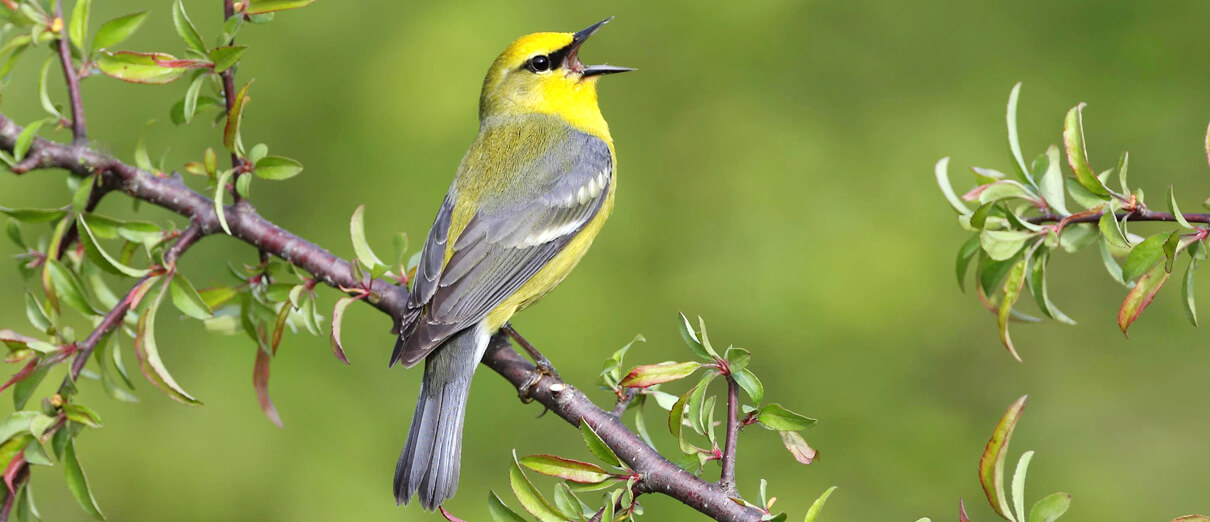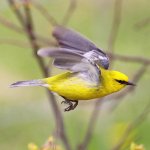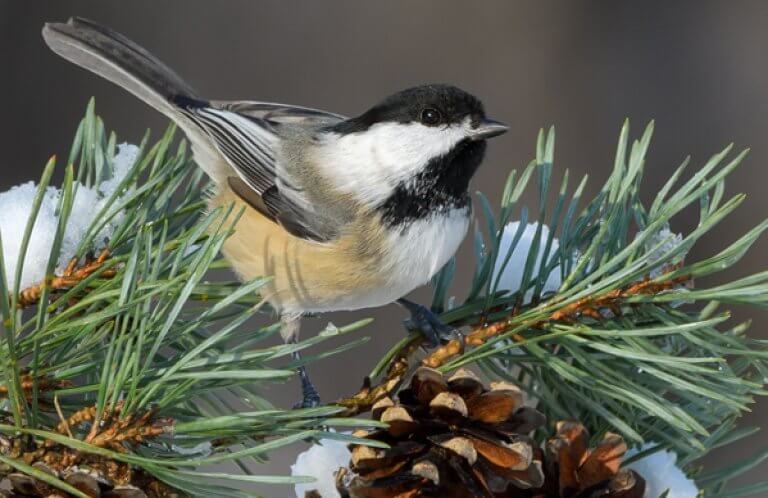About the Blue-winged Warbler
To a casual observer, the vivacious Blue-winged Warbler may resemble a Prothonotary Warbler at first glance, but it differs in several crucial aspects, both in appearance and in preferred habitat. Both species have blue-gray wings, but the Blue-winged Warbler's wings also have two white wing bars. Also notable is its thin dark eyeline, which stands out against a bright yellow face, making the Blue-winged Warbler look more “made up” than the plain-faced Prothonotary.
These two warbler species use different habitats as well. The Prothonotary Warbler nests in wooded swamps or flooded bottomlands, while the Blue-winged Warbler is most often found nesting in shrubby field and forest edge habitats — areas also favored by the Golden-winged Warbler, often to the latter's detriment.
Warbler on the Move
The Blue-winged Warbler's range in North America expanded with the arrival of European settlers, as land clearing and farming created more of the scrubby habitat this species prefers. Its range continues to expand northward today, sometimes displacing the increasingly rare Golden-winged Warbler. The two species are closely related and can produce fertile offspring, resulting in hybrids of two distinct plumages known as “Brewster's” and “Lawrence's” Warblers.
Interestingly, recent research has shown that Blue-winged and Golden-winged Warblers are almost 100 percent genetically identical and were hybridizing long before Europeans arrived.
Songs and Sounds
Male Blue-winged Warblers sing several types of song. The first, and most common, is an insect-like “beeee-buzzzz.” The second song type, most often heard while the male is defending its nesting territory, is a more complex series of buzzy notes, twitters, and trills.
Listen here:
Song type 1:
Song type 2:
Breeding and Feeding
Blue-winged Warblers form pair bonds soon after returning to their breeding grounds. Once mated, the female Blue-winged Warbler builds a well-concealed nest of grasses, leaves, and bark shreds on the ground or low in a bush, where she lays her clutch of four to five eggs.
The female incubates the eggs herself, although her mate remains close by and will feed her while she's on the nest. After the eggs hatch, both the male and female feed the nestlings and continue to do so after the young birds fledge. Unfortunately, this species is often parasitized by Brown-headed Cowbirds.

This Bill Was Made for Gleaning
The Blue-winged Warbler's genus name, Vermivora, means "worm-eating," an inaccurate description of this bird's insectivorous diet. It has a sharply pointed bill that serves as an effective tool for gleaning leaves and buds as the bird hunts for small insects, spiders, and other invertebrates. This species is an acrobatic feeder, sometimes hanging upside-down like a Black-capped Chickadee as it moves through thick underbrush in search of prey.
Region and Range
The Blue-winged Warbler breeds in the central-eastern U.S. states and southern Ontario, with its range continuing to expand northward. In fall, it migrates south, crossing the Gulf of Mexico to winter in Mexico, Central America, and the Caribbean. Most of its wintering population concentrates along the east coast of Mexico's Yucatán Peninsula, south to Honduras.
Conservation of the Blue-winged Warbler
Like other species that breed in early successional forests, such as the Prairie Warbler, Blue-winged Warbler numbers have declined due to habitat loss. Along with other migratory birds, they also face threats ranging from collisions with towers and glass to free-roaming cats.

Help support ABC's conservation mission!
During its breeding season, the Blue-winged Warbler benefits from ABC's work to create early successional habitat for species including the American Woodcock and Northern Bobwhite. The Central Hardwoods Joint Venture, staffed and supported by ABC, has restored more than 100,000 acres of woodlands and glades that benefit the Blue-winged Warbler and other species, and continues work on revitalizing degraded bird habitats.
ABC BirdScapes, particularly the Guatemala Conservation Coast BirdScape, benefit the Blue-winged Warbler on its wintering grounds, helping to ensure healthy bird habitat along with sustainable livelihoods for communities. Other migratory birds of conservation concern, such as the Wood Thrush, also benefit from our BirdScapes approach. By conserving habitat on the wintering grounds in places such as Guatemala, we can help resident and migratory birds alike.
Get Involved
Policies enacted by the U.S. Congress and federal agencies, such as the U.S. Fish and Wildlife Service, have a huge impact on migratory birds. You can help shape these rules for the better by asking lawmakers to prioritize birds, bird habitats, and bird-friendly measures. To get started, visit ABC's Action Center.
Living a bird-friendly life can have an immediate impact on migratory birds. You can help birds that visit your yard by adding native plants to your garden, treating your windows to prevent collisions with glass, avoiding pesticides, and keeping cats indoors. To learn more, visit our Bird-Friendly Life page.
American Bird Conservancy and our Migratory Bird Joint Venture partners have improved conservation management on more than 8.5 million acres of U.S. bird habitat — an area larger than the state of Maryland — over the last ten years. That's not all: With the help of international partners, we've established a network of more than 100 areas of protected bird habitat across the Americas, helping to ensure that migratory and resident birds' needs are met during all stages of their life cycles. These are monumental undertakings, requiring the support of many, and you can help by making a gift today.






















































